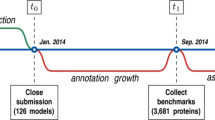Abstract
Most methods annotating protein function utilise sequence homology to proteins of experimentally known function. Such a homology-based annotation transfer is problematic and limited in scope. Therefore, computational biologists have begun to develop ab initio methods that predict aspects of function, including subcellular localization, post-translational modifications, functional type and protein-protein interactions. For the first two cases, the most accurate approaches rely on identifying short signalling motifs, while the most general methods utilise tools of artificial intelligence. An outstanding new method predicts classes of cellular function directly from sequence. Similarly, promising methods have been developed predicting protein-protein interaction partners at acceptable levels of accuracy for some pairs in entire proteomes. No matter how difficult the task, successes over the last few years have clearly paved the way for ab initio prediction of protein function.
Similar content being viewed by others
Author information
Authors and Affiliations
Corresponding author
Additional information
Received 26 March 2003; received after revision 15 May 2003; accepted 12 June 2003
Rights and permissions
About this article
Cite this article
Rost, B., Liu, J., Nair, R. et al. Automatic prediction of protein function. CMLS, Cell. Mol. Life Sci. 60, 2637–2650 (2003). https://doi.org/10.1007/s00018-003-3114-8
Issue Date:
DOI: https://doi.org/10.1007/s00018-003-3114-8




